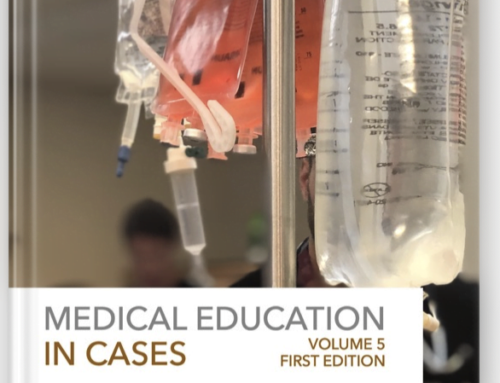
The Case of the Exasperated Educator presented an attending at the end of a difficult shift with a learner that just didn’t seem to “get it.” As the new attending coming on shift, how can we help our colleague and his student? How can we avoid getting ourselves into a similar situation? No matter patient we are, odds are that we will all find ourselves in these roles at some point or another. Check out the ALiEM community’s discussion of the case.
This month Teresa Chan (@TChanMD) and I (@Brent_Thoma) explored this issue with insights from the ALiEM community and 2 experts. This follow-up post includes:
- The responses of our medical education experts, Drs. Allison Kirkham (@AllisonKirkham) and J. Kimo Takayesu
- A summary of insights from the ALiEM community derived from the Twitter and blog discussions
- Freely downloadable PDF versions of the case and expert responses for use in continuing medical education activities
J. Kimo Takayesu, MD MS
Assistant Residency Director, Harvard-Affiliated Emergency Medicine Program
There are several issues complicating this learning interaction that relate directly to effective communication between the learner and teacher. The differential experience between an expert clinician and a novice leaves a large gap to cover when setting expectations for performance. Understanding exactly what, and how, to teach the novice requires an understanding of their current level of performance and clinical knowledge base.
In the clinical environment, assessment of performance requires direct observation to gather data that is reliable and accurate upon which to base feedback and set further learning goals [1]. Relative to the expert, the novice has limited experience in the variability of presentations, or “illness scripts”, for a particular disease, creating a large gap between learner and expert expectations of adequate performance [2]. The expectations informing assessment and feedback must be grounded in reasonable expectations of learner performance to be relevant and effective [3]. The principles of deliberate practice [4] apply throughout the spectrum of performance and, when applied to the novice, should prompt feedback directed at the leading edge of their performance that is based on a clear understanding of their current abilities.
In this case, the learner’s disjointed presentation is reflective of poor diagnostic reasoning based on inadequate information gathering [3], and the attending’s confusion is magnified because he did not observe the clinical interaction. Fatigue and workflow are also affecting the attending’s ability to be emotionally available and intellectually present. When the department gets busy, the need for assistance in clinical care supersedes learning, truncating the time to provide feedback and perform bedside teaching [5]. The clinical pressures of high volume and ED overcrowding limits his ability to directly observe the learner and devote time to exploring her learning needs.
The biggest barriers to constructive criticism are fears that the learner’s feelings will be hurt and that the feedback will be taken the wrong way [6]. Learners in difficulty require feedback that is not uniformly positive. Asking the learner for their reflections on their performance can contextualize feedback based on their learning goals, making it more relevant to their personal needs [6] – an essential feature of adult learning [7]. Feedback can be offered effectively using a three step process: set the stage by asking the learner for permission, make both positive and negative observations, and end with a clear recommendation to improve one thing [6]. There is often more than one thing to improve upon in the eyes of an expert; however, the novice may be operating at their leading edge of ability. Changing one thing is difficult; changing more than one thing may be impossible. This is much akin to juggling 5 balls as opposed to 3 (or 2). In this scenario, creating an action plan based on direct observations [6] or one facet of the presentation that demonstrates the student’s limitation in diagnostic reasoning [3] is the best first step to improving both the learner’s performance and attending’s feelings of frustration.
References
- Sherbino J, Bandiera G, Frank JR. Assessing competence in emergency medicine trainees: an overview of effective methodologies. CJEM 2008; 10(4):365-371.
- Schmidt HG, Norman GR, Boshuizen HP. A cognitive perspective on medical expertise: theory and implication. Acad Med 1990; 65(10):611-621.
- Bowen JL. Educational strategies to promote clinical diagnostic reasoning. NEJM 2006; 355(21):2217-2225.
- Ericsson KA. Deliberate practice and acquisition of expert performance: a general overview. Acad Emerg Med 2008; 15(11):988-994.
- Shayne P, Lin M, Ufberg JW, Ankel F, Barringer K, Morgan-Edwards S, DeIorio N, Asplin B. The effect of ED crowding on education: Blessing or curse? Acad EM 2009;16:76-82.
- Bernard AW, Kman NE, Khandelwal S. Feedback in the emergency medicine clerkship. West J Emerg Med 2011;12(4):537-42.
- Collins J. Education techniques for Lifelong Learning: Principles of adult learning. Radiographics. 2004;24(5):1483-9.
Allison Kirkham, BA MD MEd (Candidate)
Chief Resident, University of Alberta Emergency Medicine Residency Program
The emergency department is a rapidly-changing, complex learning environment that poses many challenges to clinical educators [1]. In addition to the inherent ED barriers of sleep deprivation, flow management and overcrowding, we face the unique educational challenges of frequent interruptions, diverse patient presentations, and inconsistent interactions with a diverse group of learners [2].
Prior to diagnosing a learner in difficulty, we must acknowledge both the communication pitfalls and contextual biases that contribute to challenging faculty-learner interactions in the emergency department.
In the case of an exasperated educator, a time out to regroup and set the stage for subsequent patient interactions is warranted. The “ED-STAT” (Emergency Department Strategies for Teaching Any Time) framework developed by Jonathan Sherbino et al. (2006) is a teaching model that can help Charlie & Bobbi get back on track [3].
| EDSTAT | Definition | Application to Scenario |
| Expectations | Every clinical environment is different. Prior to shift, articulate your operational expectations for the learner, including procedural tasks and logistics of patient review. The learner should also have the opportunity to identify learning goals and knowledge gaps. | Is case, Charlie should have taken a moment at the beginning of the shift to orient Bobbi to both the department and his management style. |
| Diagnose the learner | Whether you are working together for the first time or know the learner well, take a moment to acknowledge their level of training and familiarize yourself with the clinical objectives for that level. Consider any previously identified personal or academic challenges impacting their performance. | Opening up this conversation might reveal that Bobbi has insight into her own problems (e.g. self-identified issues with data collection during history taking). Charlie can then provide specific feedback and coaching tailored to her needs. |
| Set-up | Particularly at the novice level, ensure that you prepare the learner for success prior to the first patient interaction. Prime them with complaint-specific history questions or review a list of key features they should look for on physical exam. Be specific with expectations for investigations and review. | It would have been useful to prime Bobbi before the encounter she just completed. Priming takes advantage of the teachers expertise and makes the expectations explicit by guiding a learner through the clinician’s reasoning. |
| Teach | Consider teaching modalities that utilize shadowing and direct observation when met with a struggling learner. A “see one then watch them do one” approach allows the teacher to model optimal management and then directly observe where the learner is having difficulty. [4] Pure shadowing is a particularly effective strategy when faced with an overwhelmed department. The teacher may feel like a well-informed tour guide, but learners value the opportunity to see teachers in action too! This technique allows for flow management while still engaging the learner in a rich learning experience. | During overnight shifts, you may have to switch between multiple teaching techniques. For instance, you may initially have very junior learners “ride shotgun” as you run from room to room. When things settle down, you can directly observe the learner, providing real-time feedback. |
| Assessment & Feedback | Accurate and constructive feedback is critical, but we continue to falter when delivering negative assessments [5]. Learners experience difficulties and knowledge, skills, or attitudes. Identify which domain is lacking and provide both an example and specific recommendations for improvement. It is also important to expect and elicit feedback in return! | Charlie might instead say: “Bobbi, you appear to struggle with the differential diagnosis for chest pain. Can you review that ddx for 10 minutes then we will talk about it before the next patient?” |
| Teacher Always (Role Model) | It is impossible to omit external ED stressors from the faculty-learner relationship but it is critical to recognize when the environment influences our behavior and judgment. Self-monitoring and reflection can assist all educators in discerning whether a learner is in difficulty, or a product of an ineffective faculty-learner interaction. | Insight and self-reflection can be difficult, especially at the end of the night shift. That said, the help of a colleague or mentor can be useful. In this scenario, Justine could act as a sounding board for Charlie. With support, he might come to realize his current judgment of Bobbi is erroneous. |
Creating the optimal ED teaching environment is challenging. Recommending an ED STAT time out can help Justine diagnose the issues for both Charlie and Bobbi and help them work toward a less exasperating experience.
References
- Penciner R. Clinical teaching in a busy emergency department: strategies for success. Can J Emerg Med. 2002; 4:286–8.
- Atzema C, Bandiera G, Schull MJ. Emergency department crowding: the effect on resident education. Ann Emerg Med. 2005; 45:276–81.
- Sherbino J, Frank J, Lee C, Bandiera G. Evaluating ‘‘ED STAT!’’: A Novel and Effective Faculty Development Program to Improve Emergency Department Teaching. Academic Emergency Medicine. 2006; 13:1062–1069.
- Lake FR, Ryan G. Teaching on the run tips 11: The junior doctor in difficulty. Medical Journal of Australia. 2005;183:475
- Bernard AW, Kman NE, Khandelwal S. Feedback in the emergency medicine clerkship. West J Emerg Med. 2011;12(4):537-42.
- Langlois JP, Thach S. Managing the difficult learning situation. Family Medicine. 2000;32(5):307-9.
- Kilminster S, Cottrell D, Grant J, Jolly B. AMEE guide no. 27: effective educational and clinical supervision. Med Teach. 2007;29(1):2-19.
The comments on the case this week fell into two major themes: addressing Charlie’s exasperation with his learner, preventing struggles for learners like Bobbi in the future, and determining how much Bobbi is struggling.
Addressing the Exasperation
Anne Smith (@annestir) noted that Justine is going to need to approach this discussion with Charlie carefully. In addition to his present state of exasperation with his learner, it sounds like he is lacking sleep, dealing with a tough schedule, and having a difficult clinical shift. She suggested that a good first step might be reducing his load in some way – Amy Walsh (@docamyewalsh) thought covering his teaching responsibilities and/or difficult patients for a while so he could take a break may be effective. From here it would be helpful to determine what might be causing the disconnect between Charlie and Bobbi and whether it is just Bobbi or if he has had similar problems with other students.
Preventing Future Problems
Amy Walsh (@docamyewalsh) and Anne Smith (@annestir) noted that it is difficult to assess learners in the ED, especially during brief exposures on stressful shifts. However, Nadim Lalani (@ERMentor) suggested that Charlie may need to own some of the problem. Prior to working with a new learner it is helpful to spend some time taking their history to get an idea of their prior experiences, strengths, and weaknesses. This would allow appropriate expectations for the shift to be laid out in advance so that Charlie and Bobbie got on the same page before they ran into difficulties. Whether or not this was done effectively might help to determine whether Bobbi is having serious difficulty or just not adjusting well to the ED environment.
[/su_spoiler]Case and Responses for Download
Click Here (or on the picture below) to download the case and responses as a PDF.




